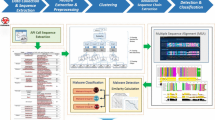Abstract
Malware became more and more sophisticated and increasingly difficult to detect, thanks to the use of evasion techniques, including anti-emulation, encapsulation, obfuscation, packing, anti-virtualization, and anti-debugger. New malware variants are generated by removing, replacing, and adding useless API calls to the malicious code. To face this increasing number of malware, it is necessary to design new detection methods, which are in charge of quickly analyzing large dataset and its variants. In this work, the sequence of state transitions performed by the applications during their execution are modeled by Markov chains, and used for malware classification. The implemented Markov chain-based detector is compared with the sequence alignment algorithm, which is widely used in the literature. The considered dataset includes 7.3 K malware and 1.2 K benign Windows applications collected over public datasets. Experimental results show that the Markov chain detector detects malware with up to 95% F-measure and outperforms detector based on sequence alignment.
Access this chapter
Tax calculation will be finalised at checkout
Purchases are for personal use only
Similar content being viewed by others
References
Hosmer, C.: Polymorphic & Metamorphic Malware. https://www.blackhat.com/presentations/bh-usa-08/Hosmer/BH_US_08_Hosmer_Polymorphic_Malware.pdf. Accessed July 2019
Ficco, M., Venticinque, S., Rak, M.: Malware detection for secure microgrids: CoSSMic case study. In: Proceedings of the IEEE International Conference on iThings/GreenCom/CPSCom/SmartData 2017, pp. 336–341 (2017)
Zhang, N., Yuan, K., Naveed, M., Zhou, X., Wang, X.: Leave me alone: app-level protection against runtime information gathering on Android. In: IEEE Symposium on Security and Privacy, pp. 915–930, May 2015
Aafer, Y., Du, W., Yin, H.: DroidAPIMiner: mining API-level features for robust malware detection in Android. In: Proceedings of the 9th International ICST Conference on Security and Privacy in Communication Networks, pp. 86–103 (2013)
D’Angelo, G., Ficco, M., Palmieri, F.: Malware detection in mobile environments based on autoencoders and API-images. J. Parallel Distrib. Comput. 137, 26–33 (2020)
Chuang, H.Y., Wang, S.-D.: Machine learning based hybrid behavior models for Android malware analysis. In: Proceedings of the 9th IEEE International Conference Software Quality, Reliability and Security, pp. 201–206, August 2015
Feng, Y., Anand, S., Dillig, I., Aiken, A.: Apposcopy: semantics based detection of Android malware through static analysis. In: Proceedings of the 22nd ACM SIGSOFT International Symposium on Foundations of Software Engineering, pp. 576–587, November 2014
Ficco, M.: Detecting IoT malware by Markov chain behavioral models. In: Proceedings of the IEEE International Conference on Cloud Engineering (IC2E), pp. 229–234 (2019)
Martín, A., Rodríguez-Fernández, V., Camacho, D.: CANDYMAN: classifying Android malware families by modelling dynamic traces with Markov chains. Eng. Appl. Artif. Intell. 74, 121–133 (2018)
Natani, P., Vidyarthi, D.: Malware detection using API function frequency with ensemble based classifier. In: Proceedings of the 1st Security in Computing and Communications (SSCC 2013). LNCS, vol. 377, pp. 378–388, August 2013
Wu, L., Ping, R., Ke, L., Hai-xin, D.: Behavior-based malware analysis and detection. In: Proceedings of the 1st International Workshop on Complexity and Data Mining (IWCDM 2011), pp. 39–42, September 2011
Cho, I.K., Kim, T., Shim, Y.J., Park, H., Choi, B., Im, E.G.: Malware similarity analysis using API sequence alignments. J. Internet Serv. Inf. Secur. 4, 103–114 (2014)
Kim, H., Khoo, W., Li, P.: Polymorphic attacks against sequence-based software birthmarks. In: Proceedings of the 2nd ACM SIGPLAN Workshop on Software Security and Protection, pp. 1–8 (2012)
Elhadi, A., Maarof, M., Barry, B.: Improving the detection of malware behavior using simplified data dependent API call graph. Int. J. Secur. Appl. 7(5), 29–42 (2013)
Mariconti, E., Onwuzurike, L., Andriotis, P., De Cristofaro, E., Ross, G., Stringhini, G.: MaMaDroid: detecting Android malware by building Markov chains of behavioral models. In: Proceedings of the 24th Network and Distributed System Security Symposium (NDSS 2017), pp. 1–22, November 2017
Canfora, G., Mercaldo, F., Visaggio, C.A.: An HMM and structural entropy based detector for Android malware: an empirical study. Comput. Secur. 61, 1–18 (2016)
Needleman, S.B., Wunsch, C.D.: A general method applicable to the search for similarities in the amino acid sequence of two proteins. J. Mol. Biol. 48(3), 443–453 (1970)
Smith, T.F., Waterman, M.S.: Identification of common molecular subsequences. J. Mol. Biol. 147(1), 195–197 (1981)
Multiple Sequence Alignment (MSA). http://www.ebi.ac.uk/Tools/msa/. Accessed Feb 2019
ClustalX, Clustal: Multiple Sequence Alignment. http://www.clustal.org/. Accessed Jan 2019
Kim, H., Kim, J., Kim, Y., Kim, I., Kim, K.J., Kim, H.: Improvement of malware detection and classification using API call sequence alignment and visualization. Cluster Comput. J. 22, 921–929 (2019)
He, R., Hu, B.-G., Zheng, W.-S., Kong, X.-W.: Robust principal component analysis based on maximum correntropy criterion. IEEE Trans. Image Process. 20(6), 1485–1494 (2011)
TEKDEFENSE malware dataset. http://www.tekdefense.com/downloads/malware-samples/. Accessed Jan 2019
Malware dataset for security researchers, data scientists. https://github.com/ocatak/malware_api_class. Accessed Jan 2019
Cuckoo Sandbox. https://cuckoosandbox.org/. Accessed Feb 2019
Weka, Open Source Machine Learning Software in Java. https://www.cs.waikato.ac.nz/~ml/weka/. Accessed Feb 2018
Ficco, M., Esposito, C., Xiang, Y., Palmieri, F.: Pseudo-dynamic testing of realistic edge-fog cloud ecosystems. IEEE Commun. Mag. 55(11), 98–104 (2017)
D’Angelo, G., Palmieri, F., Rampone, S.: Detecting unfair recommendations in trust-based pervasive environments. Inf. Sci. 486, 31–51 (2019)
Author information
Authors and Affiliations
Corresponding author
Editor information
Editors and Affiliations
Rights and permissions
Copyright information
© 2020 Springer Nature Switzerland AG
About this paper
Cite this paper
Ficco, M. (2020). Comparing API Call Sequence Algorithms for Malware Detection. In: Barolli, L., Amato, F., Moscato, F., Enokido, T., Takizawa, M. (eds) Web, Artificial Intelligence and Network Applications. WAINA 2020. Advances in Intelligent Systems and Computing, vol 1150. Springer, Cham. https://doi.org/10.1007/978-3-030-44038-1_77
Download citation
DOI: https://doi.org/10.1007/978-3-030-44038-1_77
Published:
Publisher Name: Springer, Cham
Print ISBN: 978-3-030-44037-4
Online ISBN: 978-3-030-44038-1
eBook Packages: Intelligent Technologies and RoboticsIntelligent Technologies and Robotics (R0)




